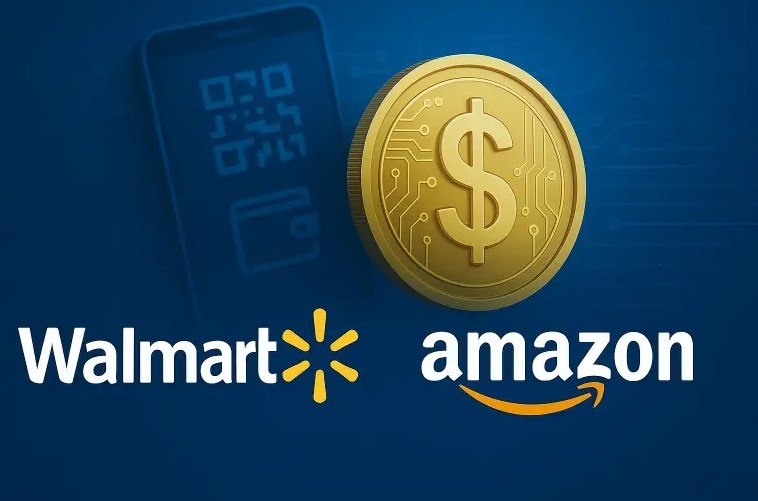The Era of Stablecoins: Walmart and Amazon Accelerate Crypto Payments — but Could Undermine the Foundations of Visa and Mastercard
Retail giants like Walmart and Amazon are rapidly expanding their stablecoin payment initiatives. While this may appear to be a technical innovation, it is, in fact, a direct challenge to the dominanc

Retail giants like Walmart and Amazon are rapidly expanding their stablecoin payment initiatives. While this may appear to be a technical innovation, it is, in fact, a direct challenge to the dominance of traditional payment titans like Visa and Mastercard. With billions of dollars in annual transaction fees on the line, these retail behemoths are seeking a disruptive solution that could fundamentally rewrite the rules of the game.
Walmart, Amazon, and other multinational corporations have recently begun exploring the possibility of issuing their own stablecoins in the U.S. Online travel giant Expedia and other large enterprises, including airlines, are also reportedly considering similar initiatives.

Their motivation isn't a passion for crypto innovation—it’s a strategic maneuver to gain leverage in longstanding fee disputes with Visa and Mastercard, or even bypass traditional payment networks entirely. Every year, these retailers pay billions of dollars in fees tied to conventional card systems, including interchange fees for customer card transactions. On top of that, settlement can take days, delaying merchant access to sales revenue.
“The reason why the fees are so high is that Visa and Mastercard each organize banks all around the country into the dictionary definition of a pricing cartel, and they tell them how much to charge merchants,” said Doug Kantor, general counsel for the National Association of Convenience Stores. “The result is all of these banks that are supposed to be competitors, don’t compete on the price to merchants of accepting a card.”
Retail giants have long sought alternative payment methods to break free from the card-based system dominated by Visa and Mastercard.
Walmart is already a leader in bank-based payments, which allow consumers to pay merchants directly from their bank accounts without using credit or debit cards. Last year, Walmart announced an upgraded version of this direct bank payment service.
Walmart has also lobbied for an amendment to the GENIUS Act that would introduce more competition into the credit card industry. The company has long aimed to expand into financial services, hoping to leverage its massive network of weekly customers and employees.
Amazon’s efforts are still in early stages, with some discussions focused on launching its own token for online purchases. Even if Amazon chooses not to issue its own stablecoin, the company is exploring the use of third-party stablecoins through merchant alliances led by stablecoin issuers.
With the Trump administration easing crypto regulations and pushing the GENIUS Act to establish a regulatory framework for stablecoins, these digital currencies are experiencing unprecedented momentum.
Commercial trade groups led by the merchant payments coalition have been actively engaging with U.S. lawmakers in recent months to support the GENIUS Act. These organizations argue that a stablecoin framework would offer merchants a viable alternative to traditional payments, significantly lowering fees and introducing real competition to Visa and Mastercard.
Traditional players like Visa and Mastercard aren’t standing still in the face of this potential disruption. Both companies are working to position themselves as essential infrastructure providers in the stablecoin ecosystem
Last year, Visa launched a platform to help banks issue fiat-backed tokens. More recently, Visa partnered with Stripe’s Bridge unit to enable companies to offer credit cards linked to stablecoins. Mastercard, meanwhile, has expanded stablecoin settlement support for merchants.
Other ecosystem players are moving fast as well. Shopify Inc. announced this week that it would enable merchants on its platform to accept stablecoin payments, powered by Stripe Inc. and Coinbase Global Inc. Stripe’s recently acquired Bridge unit also provides a platform for businesses to launch their own stablecoins. PayPal is also building a platform that enables merchants to pay overseas suppliers in stablecoins.
However, stablecoins come with their own friction points. Consumers must have crypto wallets—typically set up through third-party platforms like MetaMask or Coinbase Wallet—adding extra complexity to the purchase process. More critically, consumers need to see clear benefits over credit cards, especially since traditional cards often offer rewards.
Yet history suggests this won’t be an easy path. Bank-based payments have struggled to gain traction in the U.S., leaving a trail of failed initiatives. One example: the Merchant Customer Exchange (MCX), backed by retailers including Walmart and Target, failed to achieve widespread adoption and was acquired by JPMorgan nearly a decade ago.
Disclaimer: The views in this article are from the original Creator and do not represent the views or position of Hawk Insight. The content of the article is for reference, communication and learning only, and does not constitute investment advice. If it involves copyright issues, please contact us for deletion.